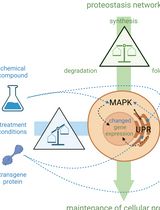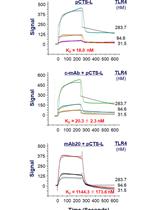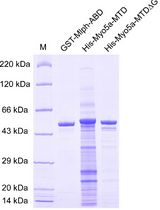- EN - English
- CN - 中文
Bioluminescence Resonance Energy Transfer (BRET) Assay for Determination of Molecular Interactions in Living Cells
采用生物发光共振能量转移(BRET)技术测定活细胞中分子的相互作用
发布: 2017年11月20日第7卷第22期 DOI: 10.21769/BioProtoc.2904 浏览次数: 22376
评审: Anonymous reviewer(s)

相关实验方案

Cell-Sonar:通过特定蛋白标志物表达变化追踪目标蛋白的简便低成本方法
Sabrina Brockmöller [...] Simone Rothmiller
2025年02月05日 1486 阅读
Abstract
The bioluminescence resonance energy transfer (BRET) assay can be used as an indicator of molecular approximation and/or interaction. A significant resonance energy transfer signal is generated when the acceptor, having the appropriate spectral overlap with the donor emission, is approximated with the donor. In the example provided, proteins tagged with bioluminescent Renilla luciferase (Rlu) as donor and yellow fluorescent protein (YFP) as acceptor were co-expressed in cells. This pair of donor and acceptor have an approximate Förster distance of 4.4 nm, providing the optimal working distance (Dacres et al., 2010). This technique can be used to explore the time-course of specific molecular interactions that occur in living cells.
Keywords: BRET assay (BRET测定法)Background
Bioluminescence resonance energy transfer (BRET) studies, using a bioluminescence donor and a fluorescence acceptor, can monitor molecular interactions (such as between labeled proteins, peptides, or small molecules) occurring in real time in living cells. This approach is dependent on spatial approximation between the donor and acceptor, as well as appropriate spectral overlap to yield a meaningful signal (Figure 1). The example currently provided utilizes a Rlu-tagged protein as the donor and a YFP-tagged protein as acceptor (Harikumar et al., 2007). This has been very successfully applied to establish the presence of physiologically-relevant protein-protein interactions in the plasma membrane of living cells. It is important, however, to include controls for levels of expression that could cause non-specific protein-protein approximation and energy transfer (bystander effect), such as the use of similar levels of expression of a known non-associated protein. Also, competition with an unlabeled protein can help to establish the saturability of the interaction and the specificity of the signal. 
Figure 1. Illustration of relevant events in a BRET experiment in a living cell. The energy transfer reaction is initiated by adding the luciferase substrate, coelenterazine-h, to cells expressing both molecules tagged with Rlu (donor) and with yellow fluorescent protein (acceptor). The Rlu emits light with a wavelength of approximately 475 nm that then excites the YFP to emit light at approximately 525 nm that can be quantified to represent the BRET signal. The approximate Fӧrster distance for this pair of donor-acceptor is approximately 4.4 nm.
Materials and Reagents
- Pipette tips (USA Scientific, catalog number: 1111-1700 )
- 100-mm tissue culture grade plastic plates (SARSTEDT, catalog number: 83.3902 )
- 5 ml tissue culture tubes (Corning, Falcon®, catalog number: 352052 )
- Cell culture flasks (Corning, catalog number: 3056 )
- 96-well OptiPlates (PerkinElmer, catalog number: 6005290 )
- 15 ml conical tube (Thermo Fisher Scientific, Thermo ScientificTM, catalog number: 339650 )
- Pasteur pipette (Fisher Scientific, catalog number: 13-678-20B )
- Rapid flow bottle-top filter unit with polyethersulfone (PES) membrane (Thermo Fisher Scientific, Thermo ScientificTM, catalog number: 595-3320 )
- PS1/PS2-deleted HTL cells
Note: This cell line was derived by Xu et al., 2016, utilizing CRISPR/Cas9 to delete PS1/PS2 from HTL cells, representing a cell line derived from HEK293 cells by Barnea and Axel who stably integrated a luciferase reporter under the control of the bacterial operator element tetO. These cells were used in this case to correlate with specific functional assays requiring a specialized cell type. In a general protocol, any transfectable cell type is fine.
- Dulbecco’s modified Eagle’s medium powder (DMEM) (Thermo Fisher Scientific, GibcoTM, catalog number: 12100-038 ) (see Recipe 6 for media preparation)
- Fetal Clone II supplement, a bovine serum product (GE Healthcare, HycloneTM, catalog number: SH30066.03 )
- Trypsin 0.25%-EDTA (Thermo Fisher Scientific, GibcoTM, catalog number: 25200056 ) diluted to 0.05% with 1x Dulbecco’s phosphate buffered saline, pH 6.80
- DEAE-dextran hydrochloride (Sigma-Aldrich, catalog number: D9885 )
- Dimethyl sulfoxide (DMSO) (Fisher Biotech, catalog number: BP231-1 )
- Chloroquine diphosphate salt (Sigma-Aldrich, catalog number: C6628 )
- Enzyme-free cell dissociation solution (EMD Millipore, catalog number: S-014-C )
- Sodium phosphate dibasic (Na2HPO4) (Sigma-Aldrich, catalog number: S0876 )
- Potassium phosphate monobasic (KH2PO4) (Fisher Scientific, catalog number: P285 )
- Sodium chloride (NaCl) (Fisher Scientific, catalog number: S671-500 )
- Potassium chloride (KCl) (Sigma-Aldrich, catalog number: P9541 )
- HEPES (Research Products International, catalog number: H75030-1000 )
- Magnesium sulfate heptahydrate (MgSO4·7H2O) (Sigma-Aldrich, catalog number: M1880 )
- Calcium chloride dihydrate (CaCl2·2H2O) (Fisher Scientific, catalog number: C79-500 )
- Sodium hydroxide (NaOH) (VWR, catalog number: BDH7247-1 )
- Coelenterazine-h (AAT Bioquest, catalog number: 21165 ) (see Recipe 5 for preparation of stock solution)
- Methanol (Honeywell International, catalog number: 24229 )
- Penicillin-streptomycin (Thermo Fisher Scientific, GibcoTM, catalog number: 15140122 )
- Sodium bicarbonate (Fisher Scientific, catalog number: BP328-500 )
- Hydrochloric acid (HCl) (Fisher Scientific, catalog number: A144-212 )
- 10x phosphate-buffered saline (PBS buffer) (see Recipes)
- 10x Kreb’s-Ringers-HEPES stock solution (10x KRH) (see Recipes)
- 50x CaCl2 stock solution (see Recipes)
- 1x KRH working solution (see Recipes)
- Coelenterazine-h solution (see Recipes)
- 1x DMEM tissue culture medium (see Recipes)
Equipment
- 37 °C, 5% CO2 incubator (Thermo Fisher Scientific, Thermo ScientificTM, model: FormaTM Series II 3110 Water-Jacketed)
- Cell culture microscope (Fisher Scientific)
- Micropipettes (Gilson)
- 2103 EnVision Plate Reader (PerkinElmer, model: 2103 EnVisionTM )
- Centrifuge (Thermo Fisher Scientific, Thermo ScientificTM, model: SorvallTM LegendTM XT/XF centrifuge , catalog number : 75216362)
- 500 ml screw-cap autoclaved glass bottles (WHEATON, catalog number: 219759 )
Software
- GraphPad Prism 6 (GraphPad Software, Inc. USA)
Procedure
文章信息
版权信息
© 2017 The Authors; exclusive licensee Bio-protocol LLC.
如何引用
Readers should cite both the Bio-protocol article and the original research article where this protocol was used:
- Harikumar, K. G., Yan, Y., Xu, T., Melcher, K., Xu, H. E. and Miller, L. J. (2017). Bioluminescence Resonance Energy Transfer (BRET) Assay for Determination of Molecular Interactions in Living Cells. Bio-protocol 7(22): e2904. DOI: 10.21769/BioProtoc.2904.
- Yan, Y., Xu, T. H., Harikumar, K. G., Miller, L. J., Melcher, K. and Xu, H. E. (2017a). Dimerization of the transmembrane domain of amyloid precursor protein is determined by residues around the gamma-secretase cleavage sites. J Biol Chem, 292: 15826-15837.
分类
生物化学 > 蛋白质 > 相互作用 > 蛋白质-蛋白质相互作用
分子生物学 > 蛋白质 > 蛋白质-蛋白质相互作用
您对这篇实验方法有问题吗?
在此处发布您的问题,我们将邀请本文作者来回答。同时,我们会将您的问题发布到Bio-protocol Exchange,以便寻求社区成员的帮助。
提问指南
+ 问题描述
写下详细的问题描述,包括所有有助于他人回答您问题的信息(例如实验过程、条件和相关图像等)。
Share
Bluesky
X
Copy link












